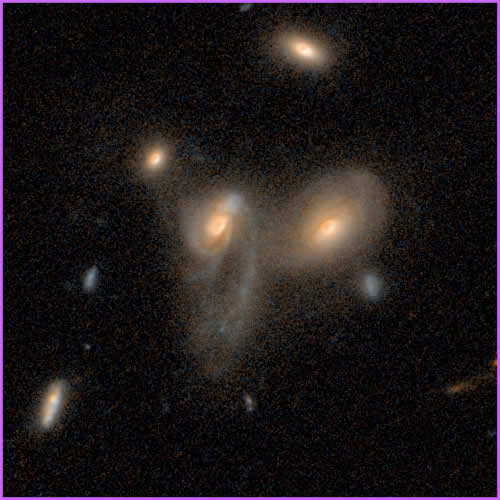 |
 |
Before the Collision: Galaxy Interactions When you see galaxies next to one another (or even on top of one another!) in the sky, it doesn't necessarily mean that they are actually near one another in space. One may be many millions of light years further away than the other---we have no depth perception when looking at objects in space! However, the galaxies in this image are in fact near one another, rather than being a chance projection. How can we tell? |
One way we can know that these galaxies do genuinely form a group in space is by measuring their distances. If they are all the same distance away from us, we know that they are in fact near one another. Measuring distances to astronomical objects has always been difficult. For distant galaxies like these, it is much easier to measure the redshift of the galaxy. As light from the galaxy travels through space, it gets stretched by the expansion of the universe. The redshift is the amount the light has been stretched during its journey from the galaxy to us, and it tells us how much space has stretched between us and the galaxy. Light coming from more distant objects will be more strongly redshifted than light coming from nearby objects, thus measuring the redshift is one way of measuring distances to these galaxies. One member team of the AEGIS survey, the DEEP2 team, has measured redshifts for some of the galaxies in this image. They find that the galaxies have almost identical redshifts, suggesting that they are at about the same distance from us, so we know that the galaxies must be a genuine group rather than a chance projection on the sky. These galaxies are 4 billion light years away, so in this image we see the galaxies as they were 4 billion years ago. |
There is another indication that at least some of the galaxies in this image really do form a group in space. The galaxy in the center of the image has clearly visible spiral arms, which are bluer in color than the center of the galaxy. However, the spiral arms are highly asymmetrical; one of the arms extends very far out from the galaxy center, pointing down toward the bottom of the image. This long streamer of stars is characteristic of a gravitational interaction between two galaxies. It has probably been stretched out from the galaxy by the passage of another galaxy nearby. The galaxy immediately to the right of the center galaxy is likely to blame, because it too seems slightly asymmetrical and appears to be sharing stars with the central galaxy. |
These two galaxies are bound together by gravity. The galaxy at the top of the image is at the same redshift, so it is also a member of a group and is also gravitationally bound to the two central galaxies. The other galaxies in the image do not have measured redshifts and there are no obvious tidal features connecting them, so they may or may not also be group members. The two interacting galaxies in the center will soon be pulled together by gravity and will entirely merge into one galaxy, called a "merger remnant". This merger remnant will start out looking very asymmetrical and chaotic, but will eventually settle down over a billion years or so to look like a normal elliptical galaxy. In fact, this merging process is one of the best current theories for how elliptical galaxies form. Mergers like this were very common in the early universe, but seem to occur less frequently now. The galaxy merger rate appears to have been declining for at least the last 6 billion years. It is too late for these galaxies, though! Long before the light from these interacting galaxies even reached the Hubble Space Telescope and imprinted this image, they had already completely merged into a single galaxy. |